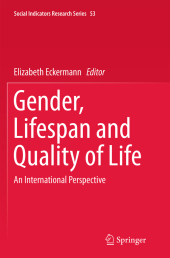 Neuerscheinungen 2016Stand: 2020-02-01 |
Schnellsuche
ISBN/Stichwort/Autor
|
Herderstraße 10
10625 Berlin
Tel.: 030 315 714 16
Fax 030 315 714 14
info@buchspektrum.de |

Elizabeth Eckermann
Gender, Lifespan and Quality of Life
An International Perspective
Herausgegeben von Eckermann, Elizabeth
Softcover reprint of the original 1st ed. 2014. 2016. viii, 276 S. 60 SW-Abb., 69 Tabellen. 235 mm
Verlag/Jahr: SPRINGER NETHERLANDS; SPRINGER 2016
ISBN: 9402404899 (9402404899)
Neue ISBN: 978-9402404890 (9789402404890)
Preis und Lieferzeit: Bitte klicken
This publication addresses the gender dimensions of people´s lived experience and emphasizes how gender relationships differentially impact on women´s and girls´ as well as men´s and boys´ subjective well-being across the lifespan. It therefore fills a significant gap in the literature on quality of life and subjective well-being. The book brings together research which compares female´s and male´s subjective experiences of well-being at various life stages from a variety of countries and regions, particularly focusing on women´s subjective well-being. Sex-disaggregation of data on objective conditions of quality of life is now routinely undertaken in many countries of the world. However, despite the burgeoning of objective data on sex differences in life conditions across the world, very little gender analysis is carried out to explain fully such difference and there is still a serious dearth of data on gender differences in subjective experiences of quality of life and well-being. This publication will assist researchers, teachers, service providers and policy makers in filling some of the gaps in currently available literature on the nexus between age and gender in producing differential experiences of subjective wellbeing.
Chapter 1: Introduction: Why Is It Important to Sex Disaggregate and Gender Analyse Quality of Life Data? Liz Eckermann.- Chapter 2: Well-Being and Communication of 12 to 16 Year-Old Girls and Their Mothers: Gender and Intergenerational Issues in Spain; Mònica González, Cristina Figuer, Sara Malo and Ferran Casas.- Chapter 3: Gender Dimensions of Quality of Life for Adults in Australia; Robert Cummins, David Mellor and Mark Stokes.- Chapter 4: Chasing the Good Life: Gender Differences in Work Aspirations of American Men and Women; Anke C. Plagnol.- Chapter 5: Gender Dimensions of Quality of Life in Algeria; Habib Tiliouine.- Chapter 6: Mothers and Quality of Life in 26 EU Countries; Piotr Michon.- Chapter 7: Gender Dimensions of Quality of Life in Romania; Sergiu Baltatescu.- Chapter 8: Quality of Life for Pregnant and Recent Parity Women in Laos; Liz Eckermann, Anna Scopaz and Matthew Clarke.- Chapter 9: Gender Dimensions of Quality of Life in Russia; Ekaterina Uglanova.- Chapter 10: Re-marry Fast, Die Young: The Gender Related Happiness Inequalities Among Polish Adults; Piotr Michon.- Chapter 11: Gender Considerations on Income and Health in Latin America; Karen Watkins Fassler.- Chapter 12: Subjective Well-Being Across Gender and Age in Japan: An Econometric Analysis; Tim Tiefenbach and Florian Kohlbacher.- Chapter 13: Gender Role Attitudes, Family Formation and Well-Being in Ireland; Margret Fine-Davis.- Chapter 14: Gender and Quality of Life in Singapore; Siok Kuan Tambyah and Soo Jiuan Tan.- Chapter 15: Age and Gender Differences in Well-Being in Croatia; Ljiljana Kaliterna and Josip Burusic.- Chapter 16: Conclusion and Policy Implications; Liz Eckermann.


